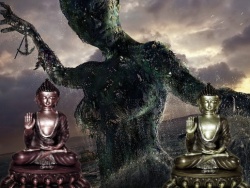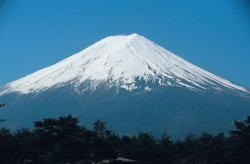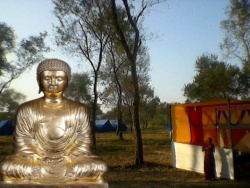The Contemporaries of the Buddha
Lanka Daily News Dr. Senarath TENNAKOON 2012-07-19
There were some famous female disciples like Sundari and Jambu. Sundari was made use of by the Paribbajikas to insult the Buddha and she was later murdered by them. Jambu was a famous debater. There were naked saudus called Achelas or Achelakas who too practiced extreme austerities (Attakilamatanuyoga). They had very unpleasant eating habits. They wore tree barks, slept on tree tops or on lawns. Some were like animals though they had human forms. They bathed in dust and sand.
The other group was the A:jeevakas. They were wandering ascetics who were naked or half naked who carried a pole and depended on food brought by their followers. They practiced definite ways of living. They also bathed in dust. Some lived in hermitages.
They opposed the Buddha's doctrine of Causality (Dependent Origination). The next group was the Jatilas or the Jatilakas, who were wondering ascetics distinguishable by their matted hair. They worshipped the Fire God and they believed in karmic action. They were fond of water sport and used to bathe often and wet their hair as water purification (Udaks Suddi).
The famous three Jatila teachers Uruwela, Nadi and Gaya Kassapa and their followers became followers of the Buddha by chopping off their matted hair and throwing them into a nearby river. Then there were the Niganthas who were strict believers in escaping from worldly bondage. They were the followers of mahavira and they had favourable connections with the royal families.
They practiced total non violence and some were naked while some wore a white cloth. They practiced severe fasting on a scheduled basis. Some were very intelligent and were excellent debaters. After the great renunciation Prince Siddhartha (the Bodhisattva) paid visits to some reputed hermits of the time who were practicing austerities. He followed Bhargiva, Alra Kalama and, Uddaka Rama Putta.
But He realized that they could not help in his pursuit. Then He began to wonder around Uruvela and met the five mendicants, Kondanna, Bhaddiya, Vappa, Mahanama and Assaji; who were also trying hard to find emancipation by practicing Attakilamatanuyoga. But was not satisfied with anyone of them. So he left them and started on his own by following the Middle Path.
The Samannaphala Sutta mentions of sixty two such teachers (Sramanas) who were in the persistent search of salvation (moksha) through practising austerities. Among them there were six prominent teachers namely Purana Kassapa, Makkhali Gosala, Ajitha Kesakambala, Pakuda Kachchayana, Sanjaya Bellattiputta and Nigantha Nagaputta respectively. Each of them had some followers.
Purana Kassapa primarily misbelieved in Kamma and Kamma Vipaka as well as on good and bad deeds. His doctrine of akariyavada namely that good and bad actions have no consequences for the agent, was strongly rejected by the Buddha as a counter concept to the concept of karma.
Makkhali Gosala was the founder of the A:jevaka sect who practised extreme austerity. He was a determinist and excessively believed in fate or destiny controlled everything and that moral choice was an illusion. He was a fatalist. The Buddha often criticized Ghosala for holding such perverse beliefs.
Ajitha Kesakambala was a nihilist who held the view that there was no such thing as good or evil and the individual would annihilate at death. He used to wear a bad smelling blanket of human hair. He was one of the earliest materialists and he never believed in karma and its effects nor in rebirth.
Pakudha Kachchayana taught a doctrine of seven eternal and unchangeable principles, consisting of elements like pleasure, pain and the soul (atman).
According to him these principles cannot be controlled by man. For example, if ones head is split by a sword there is no guilt as all that has happened is that certain atoms have rearranged (Keown, 2003). His seven elements were Pathavi (Solidity), Apokaya (Liquidity), Tejokaya (Heat), Vayokaya (Air), Sukka (Happiness), Dukka (Unhappiness) and Jiva (Life). These were silent, unchangeable, not giving problems to others. He was neither a materialist nor an activist.
Sanjaya Bellattiputta was a skeptic who would not offer any opinion on any matter Sanjaya was said to be the former teacher of Sariputta and Mahamaudgalyana before they abandoned him and followed the Buddha.
He was considered as an 'eel wriggler' (amarawikkhepika) who escaped from arguments without giving a definite solution or answer. But Sanjaya was a reputed teacher among the several religious people.
Nigantha Nathaputta practised Jainism and he practised four methods of Sila known as Catuyama Samvara Sila. This practice included the following;
1. Avoidance of using any kind of cold water
2. Sabbam Cari Yutto-Practice of any kind of virtue (si:a) moral practice.
3. Sabba Cari Danto-Avoidance of any kind of misconduct (pa:pa) and
4. Sabba Cari Putto-Release practising any kind of misconduct (pa:pa). He was known as Mahjavira and he was as extremist who practised non violence to the letter. Mahavira was more progressive than the other five teachers. Once Mahavira sent his most intelligent disciple Upali to question the Buddha about kamma. What happened was amazing as Upali became a follower of the Buddha as he was so pleased with the Buddha's way of explaining matters.


